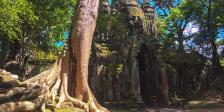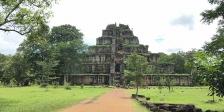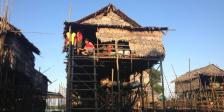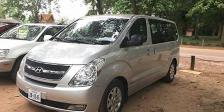Cambodia's Great Lake, the Boeung Tonle Sap (Tonle Sap Lake,) is the most prominent feature on the map of Cambodia - a huge dumbbell-shaped body of water stretching across the northwest section of the country. In the wet season, the Tonle Sap Lake is one of the largest freshwater lakes in Asia, swelling to an expansive 12,000 km2. During the dry half of the year the Lake shrinks to as small as 2500 km2, draining into the Tonle Sap River, which meanders southeast, eventually merging with the Mekong River at the 'chaktomuk' confluence of rivers opposite Phnom Penh. But during the wet season a unique hydrologic phenomenon causes the river to reverse direction, filling the lake instead of draining it. The engine of this phenomenon is the Mekong River, which becomes bloated with snow melt and runoff from the monsoon rains in the wet season. The swollen Mekong backs up into the Tonle Sap River at the point where the rivers meet at the 'chaktomuk' confluence, forcing the waters of the Tonle Sap River back upriver into the lake. The inflow expands the surface area of lake more than five-fold, inundating the surrounding forested floodplain and supporting an extraordinarily rich and diverse eco-system. More than 100 varieties of waterbirds including several threatened and endangered species, over 200 species of fish, as well as crocodiles, turtles, macaques, otter and other wildlife inhabit the inundated mangrove forests. The Lake is also an important commercial resource, providing more than half of the fish consumed in Cambodia. In harmony with the specialized ecosystems, the human occupations at the edges of the lake is similarly distinctive - floating villages, towering stilted houses, huge fish traps, and an economy and way of life deeply intertwined with the lake, the fish, the wildlife and the cycles of rising and falling waters.
The lake sits only about 15 km south of Siem Reap town. If you take the ferry between Phnom Penh and Siem Reap you will cross the lake and dock at the village of Chong Khneas. There are several ways to see the culture and wildlife of the lake area depending on the amount of time you have and your interest.
Chong Khneas
Chong Khneas is the floating village at the edge of the lake closest and most accessible to Siem Reap. If you want a relatively quick and easy look at the Tonle Sap, boat tours of Chong Khneas are available, departing from the Chong Khneas boat docks all day long. Take a motodup or taxi the 11-15km from Siem Reap to the boat docks where there are always boats waiting for passengers. A two-hour boat trip through the floating village runs $6 and the boats may carry as many as 15 other people. The boatman will probably point out the differing Khmer and Vietnamese floating households and the floating markets, clinics, schools and other boatloads of tourists. Chong Khneas, while interesting, is over-touristed and is not as picturesque and 'unspoiled' as floating villages further from Siem Reap. The boat trip usually includes two stops: one at a touristy floating 'fish and bird exhibition' with a souvenir and snack shop, and the other at the very highly recommended Gecko Environment Centre, which offers displays and information introducing the ecology and biodiversity of the lake area.
Pearieng Bird Santuary it located between Kampong Phlouk and Chong Kneas
this sites just found in 20016 and manage by community and enviromental of province. it collected mixed variety of pecess of anininals and birds water and mountain hood.
Prek Toal Bird Sanctuary
The 'bird sanctuary' at the Prek Toal core area of the Tonle Sap Biosphere Reserve has been called "the single most important breeding ground in Southeast Asia for globally threatened large waterbirds." The Biosphere covers 31,282 hectares at the northwest tip of the Tonle Sap Lake and plays host to species including Greater and Lesser Adjuncts, Black-headed Ibis, Painted Stork, Milky Stork, Spot-billed Pelican, Grey-Headed Fish Eagle and many more species. Of the three Biosphere core areas on the Tonle Sap Lake, Prek Toal is the most accessible from Siem Reap and the most popular with birdwatchers. The best time of year for viewing is the dry season when flocks of migratory birds congregate at Prek Toal. As the dry season progresses and the water recedes, the number of birds increases but the travel to some of the more important viewing areas becomes more difficult.
Most people arrange a trip to Prek Toal through their guesthouse or a tour operator. To do it yourself, take a moto or taxi from Siem Reap to the Phnom Krom/Chong Khneas boat dock. Arrange a boat to the Prek Toal Environmental Research Station (starting at $35-$45 return,) and then from the Research Station a $5 entrance fee and $15-$25 for a guided boat tour of the sanctuary. The Research Station has information on the area's flora and fauna. There are also basic overnight accommodations at the Research Station if you want to stay the night to take full advantage of the sunset and early morning viewing hours.
Kampong Phluk
Kampong Phluk is a cluster of three villages of stilted houses built within the floodplain of the Tonle Sap about 16 km southeast of Siem Reap. The villages are primarily Khmer and have about 3000 inhabitants between them. Flooded mangrove forest surrounds the area and is home to a variety of wildlife including crab-eating macaques. During the dry season when the lake is low, the buildings in the villages seem to soar atop their 6-meter stilts exposed by the lack of water. At this time of year many of the villagers move out onto the lake and build temporary stilted houses. In the wet season when water level rises again, the villagers move back to their permanent houses on the floodplain, the stilts now hidden under the water. Kampong Phluk's economy is, as one might expect, based in fishing, primary in shrimp harvesting.
Kampong Phluk sees comparatively few foreign visitors and offers a close look at the submerged forest and lakeside village life as yet unperturbed by tourism. The area can be reached by boat from the Chong Khneas or by a combination of road and boat. Make arrangements through your guesthouse of tour operator, or charter a boat at the Chong Khneas docks (starting at $35 return for a half-day at the village). By road/boat, take a car or moto to Roluos village just off Route #6 east of Siem Reap and the take a boat through the flooded forest the rest of the way to the village. During the dry season the road is clear and you can drive all of the way to the village.
Kampong Khleang
Kampong Khleang is located on the northern lake-edge about 35 km east of Siem Reap town, more remote and less touristed than Kampong Phluk. Visitors to Kampong Khleang during the dry season are universally awestruck by the forest of stilted houses rising up to 10 meters in the air. In the wet season the waters rise to within one or two meters of the buildings. Like Kampong Phluk, Kampong Khleang is a permanent community within the floodplain of the Lake, with an economy based in fishing and surrounded by flooded forest. But Kampong Khleang is significantly larger with near 10 times the population of Kampong Phluk, making it the largest community on the Lake.
The area can be reached by boat from the Chong Khneas docks or by a combination of road to Domdek on Route #6 and then boat to the village, the best method depending on the time of year. During the dry season, boats cannot get all of the way to the main villages. Consult your guesthouse or tour operator about current conditions. Many tour operators have very little experience in this area so it is best to consult with adventure tour operators and guesthouses that specialize in this area. Small group tours begin at about $35 for a half day and range up through $70 depending on the size of the group and the type of tour. To get there yourself, either charter a boat from Chong Khneas or take car or moto to Domdek village on Route #6 east of Siem Reap, turn south and continue to the water's edge where boats wait to ferry passengers into the village. During the dry season the road is clear and you can take a car or moto all of the way to the village.)
More Bird Watching
Away from the lake, northwest of Siem Reap the Ang Trapeng Thmor Sarus Crane Reserve offers another unique birdwatching opportunity.
Ang Trapeng Thmor Sarus Crane Reserve
(The following about Ang Trapeng Thmor comes courtesy of the Sam Veasna Center.) Originating as a reservoir on the Angkorian highway 66 it was rebuilt as a man-made irrigation and water storage reservoir by slave labor during the Khmer Rouge Regime in 1976. The reservoir now harbors a unique wetland associated with grassland, dipterocarp forests and paddy fields. Aside from being a feeding ground for more than 300 Sarus Crane in the dry (non-breeding) season, more than 200 species of other birds occur here, of which 18 have been classified as globally or near globally threatened. This is also one of the handful of sites in Cambodia where the endangered Eld’s Deer can be seen. Colonies of fruit bats inhabit larger trees that are often semi submerged on the edge of the reservoir.
The best time to see the Sarus Crane is from February to May though an abundance of bird species can be viewed all year. There is also a hill top Angkorian temple a few kilometers into the forest while traditional silk weaving is still practiced in the adjacent village. A boat trip can be taken on the reservoir which depending on the time of year is 11km along and 8 wide and offers fantastic views of the surrounding countryside
Officially declared a Sarus Crane Reserve by Royal Decree in 2000 the area designated covers over 12000 Hectares, following the work of Sam Veasna and his friends at the Wildlife Conservation Society (WCS), all foreign visitors are required are required to register at the WCS Office in the adjacent village.
ATT is a day trip from Siem Reap though accommodation can be arranged at the WCS HQ (tel or organized through the Sam Veasna Center in Siem Reap (in the adjacent village, giving birdwatchers the chance of dawn sightings and offering the opportunity of visiting the massive Angkorian temple complex of Banteay Chma


 Hot Line: +855 88 7272 445
Hot Line: +855 88 7272 445










.jpg)

